Alpine lines: rare Otl Aicher prints reveal a graphic designer ahead of his time
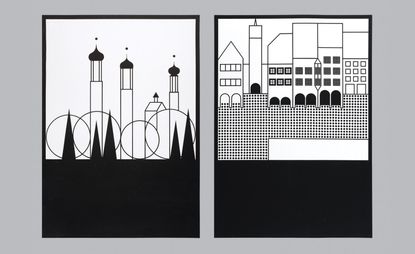
For Patrick Eley, creative director of design studio dn&co, German graphic designer Otl Aicher has long been a source of inspiration. ‘His work, particularly that of the Munich 1972 Olympics, is a design touchstone for us,’ Eley explains. ‘But his work for Isny im Allgäu is relatively little known.’
Forty years ago, the small town in southern Germany approached Aicher to create a graphic identity for its tourist board. The designer answered with a kit of 128 monochrome pictograms, in a project Eley considers to be miles ahead of its time.
And so Eley and his studio took a trip through southern Germany to blow the dust from the rare pictograms, uncovered from a ‘treasure trove of an archive’ for a new exhibition at the London Design Festival. The journey was, describes Eley, ‘the epitome of a busman’s holiday’. He was greeted by the generous hospitality of Aicher’s son Florian, and the ‘sweet beauty’ of the town itself. Both were stops along the way to a greater understanding of the man and his vision.

View of Isny, Germany
Isny, surrounded by bucolic scenery – grazing cows and charming farm houses in the foothills of the Alps – has a village feel. Aicher distills this pastoral world into a series of square landscapes, reminiscent of Polaroids, with a concrete-toned urban edge. Steeples, hillsides, forests and a curled up fox are all rendered starkly, with ‘an economy of line drawn with a mischievous twist’.
Despite their reductive aesthetic, they speak to Isny’s atmosphere. ‘Even driving into Isny, you realise the town feels familiar from Aicher’s work – you recognise its landmarks and landscapes,’ Eley offers. ‘The pictures act as vignettes, or a graphic novel, telling a comprehensive story of the place.’
Much of the studio’s own work concerns places and how to best represent them – something they were keen to express through this exhibition. ‘It explores how the pictograms work on their own and in combination with one another. It’s only when you see so much of the work in one place and in its original form, that you are able to appreciate the system Aicher created,’ Eley explains. ‘It’s flexible, playful and endlessly energetic.’
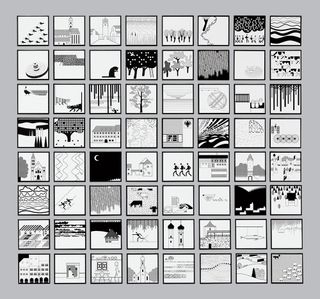
Otl Aicher’s Isny pictograms, 1960s
Viewed against the backdrop of the London Design Festival’s superfluity of far-reaching and futuristic works, Aicher’s illustrative card system seems strikingly contemporary. ‘He created a world that can be ordered and re-ordered; a system that can tell the changing stories of a place panel by panel, while remaining entirely recognisable and consistent’ – like a physical version of a Pinterest or Instagram feed.
It’s clever stuff. But Aicher’s branding programme wasn’t without controversy. About ten years after its introduction, there was an ‘outcry’ from people within the town, who felt they didn’t identify with the black and white portrayal. ‘Surrounding towns were all employing identical tourism campaigns — blue skies and the Apline ideal,’ recalls Eley. ‘The entire system was pulled in favour of something more generic.’
Little by little since the 1990s, the town has been reintroducing and reappreciating Aicher’s forward-thinking work. ‘Today, you really get a sense that it has been embraced once again,’ says Eley. ‘It backs up the universal truth that some of the best ideas are the ones that make us feel most uncomfortable at first.’

Aicher designed a series of 128 monochrome pictograms for the German town of Isny im Allgäu

Steeples, hillsides, forests and a curled up fox are all rendered with ‘an economy of line drawn with a mischievous twist’

The exhibition explores how the pictograms work on their own and in combination with one another
INFORMATION
‘Otl Aicher: Isny’ is on view until 24 September. For more information, visit the dn&co website
ADDRESS
Ground Floor Space
3 Tyers Gate
London SE1 3HX
Wallpaper* Newsletter
Receive our daily digest of inspiration, escapism and design stories from around the world direct to your inbox
Elly Parsons is the Digital Editor of Wallpaper*, where she oversees Wallpaper.com and its social platforms. She has been with the brand since 2015 in various roles, spending time as digital writer – specialising in art, technology and contemporary culture – and as deputy digital editor. She was shortlisted for a PPA Award in 2017, has written extensively for many publications, and has contributed to three books. She is a guest lecturer in digital journalism at Goldsmiths University, London, where she also holds a masters degree in creative writing. Now, her main areas of expertise include content strategy, audience engagement, and social media.
-
 Junya Ishigami designs at Maniera Gallery are as ethereal as his architecture
Junya Ishigami designs at Maniera Gallery are as ethereal as his architectureJunya Ishigami presents new furniture at Maniera Gallery in Belgium (until 31 August 2024), following the series' launch during Milan Design Week
By Ellie Stathaki Published
-
 Reciprocal House offers an unusual case of a London extension
Reciprocal House offers an unusual case of a London extensionReciprocal House by Gianni Botsford replaces a north London Victorian structure, preserving its early Norman Foster extension and bringing the whole to the 21st century
By Ellie Stathaki Published
-
 Utilitarian men’s fashion that will elevate your everyday
Utilitarian men’s fashion that will elevate your everydayFrom Prada to Margaret Howell, utilitarian and workwear-inspired men’s fashion gets an upgrade for S/S 2024
By Jack Moss Published
-
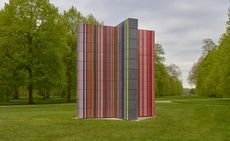 Gerhard Richter unveils new sculpture at Serpentine South
Gerhard Richter unveils new sculpture at Serpentine SouthGerhard Richter revisits themes of pattern and repetition in ‘Strip-Tower’ at London’s Serpentine South
By Hannah Silver Published
-
 Meet the Turner Prize 2024 shortlisted artists
Meet the Turner Prize 2024 shortlisted artistsThe Turner Prize 2024 shortlisted artists are Pio Abad, Claudette Johnson, Jasleen Kaur and Delaine Le Bas
By Hannah Silver Published
-
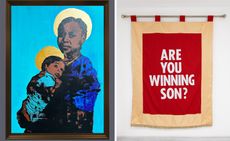 London gallery Incubator’s six emerging artists to see in spring 2024
London gallery Incubator’s six emerging artists to see in spring 2024Incubator's spring programme features six artists in consecutive two-week solo shows at the London, Chiltern Street gallery
By Mary Cleary Published
-
 Kembra Pfahler revisits ‘The Manual of Action’ for CIRCA
Kembra Pfahler revisits ‘The Manual of Action’ for CIRCAArtist Kembra Pfahler will lead a series of classes in person and online, with a short film streamed from Piccadilly Circus in London, as well as in Berlin, Milan and Seoul, over three months until 30 June 2024
By Zoe Whitfield Published
-
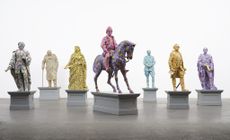 Yinka Shonibare considers the tangled relationship between Africa and Europe at Serpentine South
Yinka Shonibare considers the tangled relationship between Africa and Europe at Serpentine SouthYinka Shonibare‘s ‘Suspended States’ at Serpentine South, London, considers history, refuge and humanitarian support (until 1 September 2024)
By Tianna Williams Published
-
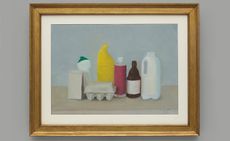 Gavin Turk subverts still-life painting and says: ‘We are what we throw away’
Gavin Turk subverts still-life painting and says: ‘We are what we throw away’Gavin Turk considers wasteful consumer culture in ‘The Conspiracy of Blindness’ at Ben Brown Fine Arts, London
By Rowland Bagnall Published
-
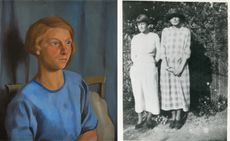 Dorothy Hepworth and Patricia Preece: Bloomsbury’s untold story
Dorothy Hepworth and Patricia Preece: Bloomsbury’s untold story‘Dorothy Hepworth and Patricia Preece: An Untold Story’ is a new exhibition at Charleston in Lewes, UK, that charts the duo's creative legacy
By Katie Tobin Published
-
 Don’t miss: Thea Djordjadze’s site-specific sculptures in London
Don’t miss: Thea Djordjadze’s site-specific sculptures in LondonThea Djordjadze’s ‘framing yours making mine’ at Sprüth Magers, London, is an exercise in restraint
By Hannah Silver Published